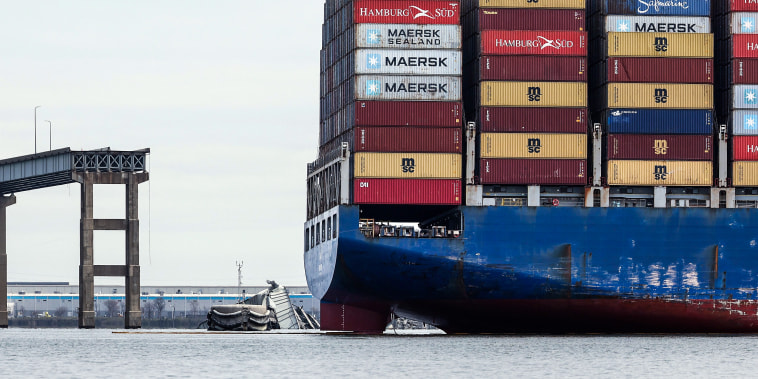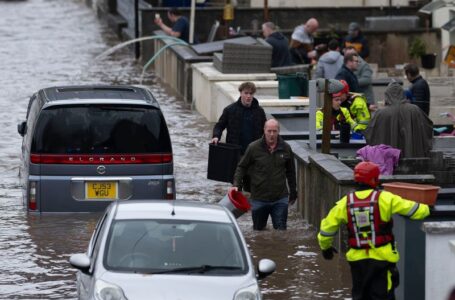Israeli cabinet sanctions country’s oldest newspaper over critical coverage and publisher’s comments
Customers from the East Coast to the Midwest could see costly impact from Baltimore bridge collapse


Customers from the East Coast to the Midwest who were expecting goods shipped in via the Port of Baltimore could see significant cost increases as a result of Tuesday’s collapse of the Francis Scott Key Bridge in Baltimore.
In a statement released after the bridge collapsed early Tuesday, the American Trucking Association estimated that 4,900 trucks per day carrying an annual average of $28 billion worth of goods would have to be rerouted — at a cost to shippers and ultimately consumers.
“The Key Bridge and Port of Baltimore are critical components of our nation’s infrastructure and supply chain,’ the association said. ‘Aside from the obvious tragedy, this incident will have significant and long-lasting impacts on the region.’
It said the greatest impact is likely to be on shipments of hazardous materials, like diesel fuel, which are not allowed to be taken through tunnels.
The closure, the association said, will ‘add significant cost in time, fuel and delays for trucks traveling through the region, on top of the disruption that a closure of the Port of Baltimore will inflict on our economy.’
“We urge state and federal government agencies to swiftly target appropriate resources to open the port and replace this bridge as quickly as possible,” the association said.
A spokesperson for the Council on Safe Transportation of Hazardous Articles said it was declining to comment on the situation.
The collapse is being blamed on a cargo ship that lost power and slammed into a bridge pylon early Tuesday. Maryland Gov. Wes Moore has declared a state of emergency, and President Joe Biden said he would direct federal resources to address the situation.
Global supply chains are already in brittle shape from pandemic-related stresses and geopolitical changes.
“If this were the only issue, I think we’d be in a much better position,’ said Abe Eshkenazi, CEO of the Association for Supply Chain Management. ‘The unfortunate circumstance is that we’ve been dealing with multiple disruptions that have already stretched a system that is low on capacity.”
Baltimore is the largest entry point in the U.S. for large agriculture and construction equipment like tractors, farming combines, forklifts, bulldozers and heavy-duty trucks that are bound for the Midwest, according to DAT Freight and Analytics, a freight-exchange service.
Any disruption to agriculture and construction equipment shipments would come at a particularly bad time as Midwest farmers have begun to plant this year’s crops, while construction picks up in colder climates as the ground begins to thaw, said Dean Croke, principal analyst with DAT.
“I think it has a huge economic impact on the farming industry,” Croke said. “This is peak planting season in the Midwest and peak machinery import season. March is the biggest month for machinery shipments into the U.S. via Baltimore.”
Companies may have to reroute their shipments to nearby ports, like those in Georgia or Florida, he said. That will mean higher freight shipping costs as trucks have to travel farther and may have to wait longer to pick up their loads if those ports become congested, Croke said.
The complete collapse of the bridge means it could take up to a year for normal logistics patterns to return, said Tinglong Dai, a professor at the Johns Hopkins Carey Business School.
‘It’s very difficult to estimate the [shipping] cost impact, but it’s fair to say it’s going to be costlier to transport autos and trucks to and from the U.S. in the short term because of the oversize impact on the port of Baltimore,’ he said.
Baltimore is also the No. 1 automobile port in the U.S. Other Eastern Seaboard ports are expected to be able to shoulder some Baltimore-bound auto shipments, said Emily Stausbøll, a market analyst with the shipping group Xeneta, which could limit the impact on global shipping rates.
“However, there is only so much port capacity available and this will leave supply chains vulnerable to any further pressure,” Stausbøll wrote in a note to clients.
In an interview with CNBC, Richard Meade, the editor-in-chief of Lloyd’s list, a shipping journal, said: “It will be expensive, but it is not a supply chain story like the Ever Given [which was stuck in the Suez Canal] because ocean carriers will find alternative routes,” Meade said. “Logistically, ocean carriers and trucking have the ability to be pretty adapt and agile.”
A spokesperson for the port of Norfolk, Virginia — another major terminal along the East Coast — said its team was already working with ocean carriers whose vessels were bound for Baltimore to see about rerouting south.
‘The Port of Virginia has a significant amount of experience in handling surges of import and export cargo and is ready to provide whatever assistance we can to the team at the Port of Baltimore,” the spokesperson said.
Some automakers said there may not be a major impact.
A spokesperson for General Motors said that it expected the incident to have a minimal effect on its operations and that it was working to reroute vehicle shipments to other ports.
A BMW spokesperson said its receiving terminal is at the Baltimore harbor’s entrance in front of the bridge and still accessible.
“We do not expect this morning’s tragedy in Baltimore to have any immediate impact on our business, other than short term traffic delays,” the BMW spokesperson said in an email.
Other companies with significant operations in the port area said the impact would be minimal. In a statement, a representative for Home Depot said its distribution centers in the area remained open and operating.
Amazon, which also has a major distribution center at the port, declined to specify what, if any, effects there might be.
‘We’re assessing the immediate and future impacts to our employees and delivery partners, as well as the surrounding community and will make any adjustments to our operations that are needed,’ an Amazon representative said in an emailed statement.











